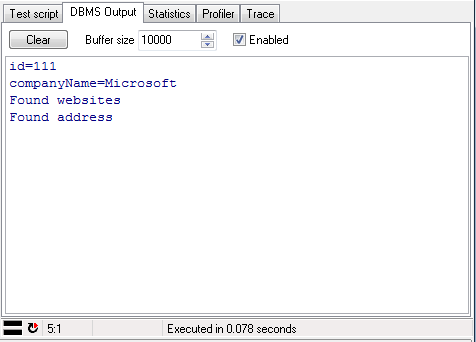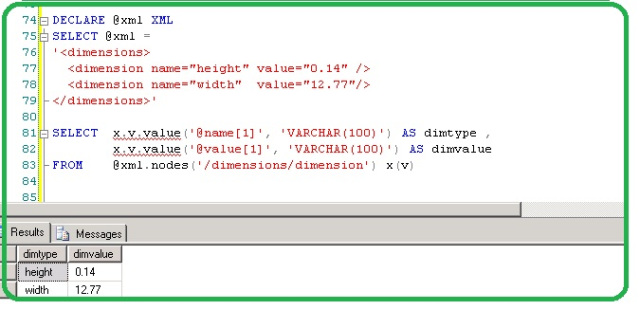

In addition to the ANY clause, you can write a subquery. You can use the output in any XML parser to produce more useful output. Each value is represented as a name-value element pair. Syntax: The syntax of the DECODE function in the PL/ SQL Oracle database is as shown in the below description DECODE ( expression /value, search expression 1, return value 1, search expression 2, return value 2.
ORACLE SELECT XML DECODE CODE
Here I will use a slightly modified form of his original code to generate vowels of the English alphabet:Īs you can see, the column STATE_CODE_XML is XMLTYPE, where the root element is.

Oracle ACE Director Lucas Jellema of Amis Technologies has shown how you can generate rows of specific data for testing purposes. Some of the very interesting uses of unpivot go beyond the usual powerful data manipulation such as the example shown earlier. So unpivot is not for undoing what pivot did, a fact you should carefully consider before creating a pivoted table and then dropping the original one. Instead the crosstab report was displayed in a different way for you to load into a relational table. Later you used unpivot on the table CUST_MATRIX but that didn't get back the details of the original table CUSTOMERS. Syntax: DECODE ( expression, search, result, search, result. The DECODE function is supported in the various versions of the Oracle/PLSQL, including, Oracle 12c, Oracle 11g, Oracle 10g and Oracle 9i. It treats a NULL expression and NULL search as equal (so NULL NULL). It is used to work as an IF-THEN-ELSE statement. As I mentioned above, the Oracle DECODE function is an exception to other functions in how it handles NULL values. For instance, in the above example, you created a new table, CUST_MATRIX, using a pivotnoperation on the table CUSTOMERS. DECODE is an advanced function that the Oracle database supports. Unpivot may be the opposite action of pivot but don't assume that former can reverse what latter has done. As you specified state_counts, that is the name of the new column created in the resultant output. XMLSERIALIZE(CONTENTXMLAGG(XML_DATA)ASCLOBNOINDENT)Purchase Frequency New York Conn New Jersey Florida MissouriĪs the column "New York" suddenly became a value in a row, how would you show the value 33048, under which column? That question is answered by the clause just above the for clause inside the unpivot operator in the above query. Select xmlserialize(content xmlagg(xml_data) as clob no indent) XMLSERIALIZE(CONTENTXMLAGG(XML_DATA)ASCLOB) Select xmlserialize(content xmlagg(xml_data) as clob) ORA-19012: Cannot convert XML fragment to the required datatype Select xmlserialize(document xmlagg(xml_data) as clob) If we try to use the DOCUMENT keyword this will fail, because this is not a valid XML document. 7 Answers Sorted by: 32 Try this instead: select xmltype (t.xml).extract ('//fax/text ()'). The following query returns three XML fragments as a single document, but it is not a valid XML document. Please abide by the Oracle Community guidelines and refrain from posting any customer or personally identifiable information (PI/CI).

In the body, insert detailed information, including Oracle product and version. Enter a title that clearly identifies the subject of your question. The CONTENT keyword can be used for collections of XML fragments that don't represent a valid XML document. Select a discussion category from the picklist. XMLSERIALIZE(DOCUMENTXML_DATAASCLOBINDENTSIZE=4) Select xmlserialize(document xml_data as clob indent size=4) Using INDENT SIZE=n allows us to specify the depth of the indent. XMLSERIALIZE(DOCUMENTXML_DATAASCLOBNOINDENT) Select xmlserialize(document xml_data as clob no indent) Select xmlserialize(document xml_data as clob)Īdding NO INDENT removes additional whitespace. The following example creates a CLOB from the XML document. The DOCUMENT keyword can only be used if the XML is a valid XML document. The XMLSERIALIZE function creates a string or LOB based on the XML passed as the value_expr. Below is query to transform to XML format select ( 'select NAME from APPName ') XMLout from dual ' Populate the table with a full XML document, and three XML fragments. The XMLSERIALIZE function was introduced in Oracle 10.1 to create a string or LOB based on the XML passed to it.Ĭreate a test table to hold XMLTYPE data. Home » Articles » 10g » Here XMLSERIALIZEORACLE SELECT XML DECODE FULL


 0 kommentar(er)
0 kommentar(er)
